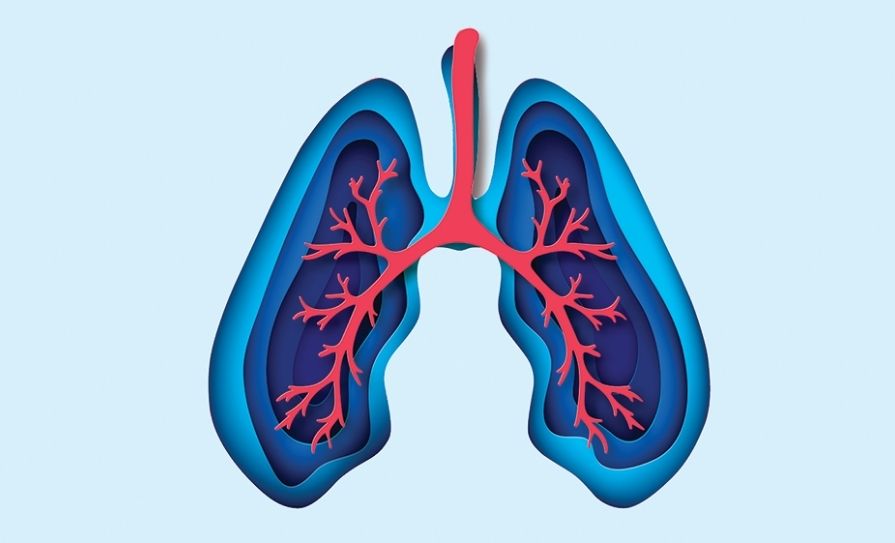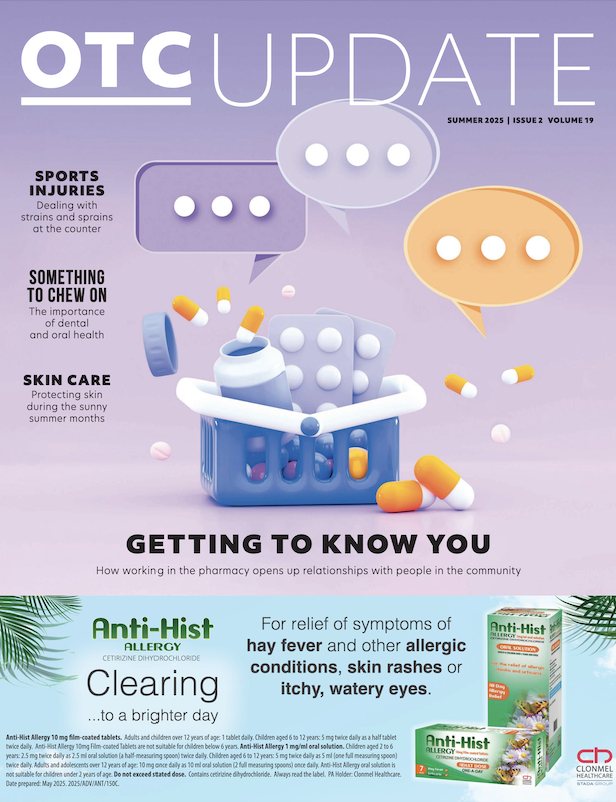Damien O’Brien gives a clinical overview of COPD, including risk factors, symptoms, treatment strategies and the role of the pharmacist
Introduction
Chronic obstructive pulmonary disease (COPD) is a progressive, irreversible condition that primarily affects the lungs. It is characterised by airflow limitation and tissue destruction resulting from chronic inflammation. This leads to structural lung changes, including airway narrowing and reduced lung recoil.
COPD encompasses both emphysema — damage to the alveoli — and chronic bronchitis, which involves long-term inflammation of the airways. It typically causes persistent breathing difficulties such as chronic cough, sputum production and dyspnoea (shortness of breath). The leading risk factor is tobacco smoke, although other contributors include occupational exposure to dust or fumes, air pollution and genetic predispositions.
COPD is a major cause of morbidity and mortality worldwide. In Ireland, an estimated 400,000 people are affected, many of whom may remain undiagnosed. It is a significant contributor to hospital admissions, particularly during the winter months when exacerbations are more common. These exacerbations can greatly impair quality of life, leading to hospitalisation, increased healthcare costs and, in severe cases, premature death. Early recognition of symptoms, particularly among those with risk factors, is essential. Pharmacists are ideally positioned in the community to support early identification and intervention.
This article will examine pathophysiology, risk factors, common symptoms, comorbidities, diagnosis, warning symptoms, non-pharmacological strategies, pharmacological management and the pharmacist’s role in COPD care. Pharmacists have an increasingly important opportunity to improve outcomes for patients through integrated, patient-centered care.
Pathophysiology and risk factors
COPD is defined by persistent, largely irreversible airflow obstruction. It arises from two primary pathological processes: Chronic bronchitis, and emphysema. Chronic bronchitis involves long-standing inflammation of the bronchi, leading to mucus overproduction and a chronic productive cough lasting at least three months in two consecutive years. The excess mucus narrows airways, increases infection risk and worsens airflow limitation. In emphysema, the alveolar walls are destroyed, reducing surface area for gas exchange. This structural damage causes air trapping and lung hyperinflation.
Tobacco smoking is the most significant risk factor for COPD, including both active smoking and second-hand exposure. Smoking causes persistent airway inflammation and accelerates lung tissue destruction. Other risk factors include occupational exposure to irritants such as dust and fumes, indoor air pollution, and recurrent lower respiratory infections in early life.
A rare but important genetic cause is alpha-1 antitrypsin deficiency, which results in insufficient antiprotease activity. This leaves lung tissue vulnerable to protease-mediated damage, increasing the risk of early- onset emphysema. Regardless of cause, COPD leads to irreversible lung damage and a progressive decline in respiratory function.
Symptoms and comorbidities
COPD typically presents in adulthood and symptoms are often more severe during the winter months. Many patients report that symptoms are worse in the morning due to overnight mucus accumulation. Common respiratory symptoms include chronic and progressive dyspnoea, cough, sputum production, wheezing and chest tightness. Breathlessness on exertion is often one of the earliest signs but may be overlooked, leading to delayed diagnosis.
In addition to the respiratory burden, COPD can have a significant psychological impact. Anxiety is common due to breathlessness, while limitations in physical activity and independence may contribute
to depression and social isolation. Comorbidities are frequent and clinically significant in patients with COPD. Cardiovascular disease — including heart failure and ischaemic heart disease — is a leading cause
of mortality in this population. Other notable comorbidities include type 2 diabetes mellitus, osteoporosis (particularly in those using long-term oral corticosteroids), and lung cancer. Pharmacists and other healthcare professionals should remain vigilant for comorbidities
and polypharmacy, to ensure safe and comprehensive care.
Diagnosis
COPD is typically suspected in patients with relevant symptoms and risk factors, such as a history of smoking or occupational exposures. Spirometry is the gold standard for confirming diagnosis. A post- bronchodilator FEV1/FVC ratio of less than 0.7 confirms persistent airflow limitation consistent with COPD. Other assessments, such as the six-minute walk test, chest imaging and blood tests, may support the diagnosis or evaluate disease severity. Pulmonary function tests are also essential for disease
staging and ongoing monitoring.
Although spirometry is generally carried out in GP or hospital settings, pharmacists can play an important role in early identification. Structured questioning in community pharmacy settings can help detect at-risk individuals who might otherwise normalise symptoms as part of ageing or smoking. By shifting this perception and encouraging early evaluation, pharmacists can contribute to earlier diagnosis, better management and reduced hospitalisation.
Non-pharmacological and preventive care
Smoking cessation is the most effective intervention to slow the progression of COPD. Continued smoking accelerates lung function decline, but stopping — regardless of disease stage — can significantly improve prognosis. Pharmacists are ideally placed to initiate smoking cessation support, with nicotine replacement therapy (NRT), varenicline and bupropion all potential treatment options.
Vaccination is another key preventive measure. Annual influenza vaccination and Covid-19 boosters reduce the risk of serious respiratory infections that can trigger exacerbations and hospitalisations. Pneumococcal vaccination is also recommended, with timing and frequency depending on the patient’s age and risk profile.
Pulmonary rehabilitation, recommended at all stages of COPD, is a structured programme combining exercise, education and behavioural support. It aims to improve physical function, psychological wellbeing and overall quality of life. Even light physical activity, such as regular walking, can help maintain lung function and reduce fatigue.
In addition to the respiratory burden, COPD can have a significant psychological impact
Nutrition also plays a critical role. Underweight patients are at greater risk of poor outcomes, while overweight individuals may experience more pronounced breathlessness on exertion. Pharmacists can collaborate with other healthcare providers to reinforce the importance of a balanced diet and hydration, and to identify early signs of malnutrition.
Finally, pharmacists can support patients by counselling them on avoiding airborne pollutants, managing energy levels and maintaining long-term lifestyle changes — key elements of non- pharmacological COPD care.
Pharmacological management
Pharmacological treatment in COPD aims to reduce symptoms, prevent exacerbations, improve exercise tolerance and enhance quality of life. Although COPD is irreversible, appropriate use of medications can significantly reduce the disease burden and help prevent hospital admissions. Treatment should be tailored to the severity of symptoms, frequency of exacerbations and the patient’s response to therapy.
Inhaled bronchodilators
Inhaled bronchodilators are the cornerstone of COPD management and form the basis of both maintenance and rescue therapy. These agents work by relaxing airway smooth muscle, improving airflow and relieving bronchoconstriction.
Short-acting beta2 agonists (SABAs), such as salbutamol and terbutaline, provide rapid relief of acute symptoms, typically within minutes. They are used as reliever inhalers. Ipratropium, a short-acting muscarinic antagonist (SAMA), also offers quick symptom relief by inhibiting acetylcholine-mediated bronchoconstriction, though it is used less frequently due to the availability of longer-acting alternatives.
Long-acting beta2 agonists (LABAs), including salmeterol and formoterol, provide sustained bronchodilation over-12 to-24 hours and are used for regular symptom control and to reduce exacerbation risk. Long-acting muscarinic antagonists (LAMAs), such as tiotropium and glycopyrronium, block muscarinic receptors and prevent cholinergic bronchoconstriction.
Dual bronchodilation with both a LABA and a LAMA is recommended for patients with persistent symptoms or frequent exacerbations despite monotherapy. Combination therapy improves lung function and symptom control more effectively than monotherapy and is considered an early escalation step for moderate- to-severe disease. Indacaterol and vilanterol are ultra-long-acting
beta2 agonists that offer once-daily dosing. Fixed-dose combination inhalers, such as indacaterol/ glycopyrronium or vilanterol/ umeclidinium, enhance convenience and may improve adherence.
Inhaled corticosteroids (ICS)
Inhaled corticosteroids have a selective role in COPD management and should be used judiciously. Their primary benefit is the reduction of airway inflammation. Unlike in asthma, they do not reverse fixed airflow limitation. Prolonged use can increase the risk of adverse effects, including pneumonia, oral candidiasis and systemic corticosteroid exposure at high doses. ICS may be indicated in patients with frequent exacerbations or hospital admissions, particularly when blood eosinophil counts suggest a likely benefit. They are also useful in patients with asthma-COPD overlap. ICS are typically used as part of triple therapy alongside a LABA and a LAMA in patients who remain symptomatic despite dual bronchodilation. Fixed-dose triple combination inhalers, including fluticasone, umeclidinium and vilanterol, are now widely used in such cases.
Administration
Effective COPD management depends not only on the right medication, but also on the appropriate delivery system. Most bronchodilator therapies are delivered via inhalers (with a spacer if needed). The choice of inhaler should consider the patient’s inspiratory flow, co-ordination and cognitive ability. Spacers improve drug delivery with pressurised metered-dose inhalers (pMDIs), particularly in patients with co- ordination difficulties. However, incorrect inhaler technique is common and can significantly reduce therapeutic efficacy.
Pharmacists play a vital role in ensuring correct technique and promoting adherence. Demonstrating inhaler use — including priming, breathing technique, breath-holding and cleaning — is essential. Regular inhaler technique checks should be a routine part of counselling.
Nebulisers may be considered during severe exacerbations or if the patient is still experiencing disabling breathlessness despite maximal inhaler therapy. Proper counselling on nebuliser use, whether with a face mask or mouthpiece, is essential for both patients and carers.
Pharmacists play a vital role in ensuring correct technique and promoting adherence
Oral corticosteroids
Short courses of oral corticosteroids, such as prednisolone, are indicated during acute exacerbations of COPD. However, long-term use is generally discouraged due to the risk of adverse effects, including osteoporosis, hyperglycaemia and mood changes. In some patients with advanced disease, long-term corticosteroid use may be necessary. In such cases, the lowest effective dose should
be used, and patients should be regularly monitored for complications, particularly osteoporosis. Prophylaxis for osteoporosis should be considered where appropriate.
Antibiotics
Antibiotics are not routinely required in stable COPD but may be appropriate during exacerbations suspected to be of bacterial origin. Indicators include increased sputum purulence, fever, systemic symptoms, elevated C-reactive protein (CRP) or a positive sputum culture. Use should align with local antibiotic stewardship guidelines.
Prophylactic antibiotic therapy may be considered in patients with frequent exacerbations (four or more per year), especially if these are prolonged, associated with sputum production or lead
to hospitalisation. This option is reserved for non-smokers who have already optimised pharmacological and non-pharmacological treatment options. Azithromycin 250mg three times per week is the typical regimen. Patients should be counselled on the potential risks, including hearing loss and tinnitus. Treatment should be reviewed every three-to-six months and continued only if benefits outweigh risks.
Methylxanthines
Methylxanthines, such as theophylline and aminophylline, are occasionally used as maintenance therapy.
Their exact mechanism is not fully understood but is believed to involve inhibition of phosphodiesterase (PDE) 3 and 4. They provide modest bronchodilation and are typically reserved for patients with severe COPD who are unable to tolerate or do not respond adequately to inhaled therapies. Due to their narrow therapeutic index and potential for significant drug interactions, close monitoring of plasma levels is essential.
Phosphodiesterase-4 (PDE4) inhibitors PDE4 inhibitors reduce inflammation by preventing the breakdown of intracellular cyclic AMP. Roflumilast is indicated in patients with severe COPD associated with chronic bronchitis and frequent exacerbations despite optimal inhaled triple therapy. Treatment should be initiated by a specialist. Adverse effects may include weight loss, nausea and psychiatric disturbances.
Other pharmacological treatments
Mucolytics, such as carbocisteine, may be considered for patients with chronic productive cough, but therapy should only be continued if symptomatic benefit is observed. Antitussives are typically not recommended in COPD due to limited efficacy. The use of antioxidant supplements, including alpha-tocopherol and beta-carotene, is not currently supported by robust evidence. Long-term oxygen therapy (LTOT) may be indicated for patients with chronic hypoxaemia and should be initiated following proper assessment in a secondary care setting.
Warning signs
Pharmacists are well positioned to identify early signs of COPD exacerbations, which may include increased breathlessness, changes in sputum colour or volume, fatigue or chest tightness. These episodes are often triggered by infections or environmental irritants and can progress rapidly if not addressed.
PDE4 inhibitors reduce inflammation by preventing
the breakdown of intracellular cyclic AMP
Frequent reliance on reliever inhalers may indicate inadequate disease control. Early recognition and intervention can reduce the risk of hospitalisation and slow long-term disease progression. Urgent referral is warranted if the patient presents with concerning signs such as confusion, drowsiness, chest pain, or a poor response to reliever medications.
The pharmacist’s role
Pharmacists serve as a vital first point of contact in the identification and long-term management of
COPD. As one of the most accessible healthcare professionals, they are uniquely positioned to support early detection, reinforce patient education and promote adherence to prescribed therapies. Through structured counselling and routine follow-ups, pharmacists can help patients manage symptoms, avoid triggers and prevent exacerbations.
Pharmacy-based services such as inhaler technique checks, medication reviews and smoking cessation programmes significantly improve symptom control and overall quality of life. Pharmacists also play a key role in promoting and administering vaccinations, helping reduce the risk of respiratory infections. Beyond the traditional dispensing role, pharmacists provide practical, patient- centered support, forming an essential part of the multidisciplinary care team for patients living with COPD.
References available upon request.







